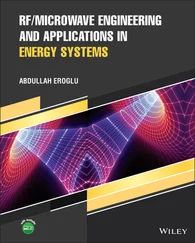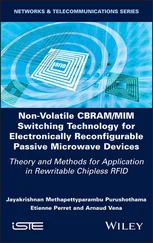Joel P. Dunsmore - Handbook of Microwave Component Measurements
Здесь есть возможность читать онлайн «Joel P. Dunsmore - Handbook of Microwave Component Measurements» — ознакомительный отрывок электронной книги совершенно бесплатно, а после прочтения отрывка купить полную версию. В некоторых случаях можно слушать аудио, скачать через торрент в формате fb2 и присутствует краткое содержание. Жанр: unrecognised, на английском языке. Описание произведения, (предисловие) а так же отзывы посетителей доступны на портале библиотеки ЛибКат.
- Название:Handbook of Microwave Component Measurements
- Автор:
- Жанр:
- Год:неизвестен
- ISBN:нет данных
- Рейтинг книги:5 / 5. Голосов: 1
-
Избранное:Добавить в избранное
- Отзывы:
-
Ваша оценка:
- 100
- 1
- 2
- 3
- 4
- 5
Handbook of Microwave Component Measurements: краткое содержание, описание и аннотация
Предлагаем к чтению аннотацию, описание, краткое содержание или предисловие (зависит от того, что написал сам автор книги «Handbook of Microwave Component Measurements»). Если вы не нашли необходимую информацию о книге — напишите в комментариях, мы постараемся отыскать её.
Handbook of Microwave Component Measurements — читать онлайн ознакомительный отрывок
Ниже представлен текст книги, разбитый по страницам. Система сохранения места последней прочитанной страницы, позволяет с удобством читать онлайн бесплатно книгу «Handbook of Microwave Component Measurements», без необходимости каждый раз заново искать на чём Вы остановились. Поставьте закладку, и сможете в любой момент перейти на страницу, на которой закончили чтение.
Интервал:
Закладка:
Table of Contents
1 Cover
2 Foreword to the Second Edition
3 Foreword to the First Edition
4 Preface to the Second Edition
5 Preface to the First Edition
6 Acknowledgments for the Second Edition
7 Acknowledgments from the First Edition
8 1 Introduction to Microwave Measurements 1.1 Modern Measurement Process 1.2 A Practical Measurement Focus 1.3 Definition of Microwave Parameters 1.4 Power Parameters 1.5 Noise Figure and Noise Parameters 1.6 Distortion Parameters 1.7 Characteristics of Microwave Components 1.8 Passive Microwave Components 1.9 Filters 1.10 Directional Couplers 1.11 Circulators and Isolators 1.12 Antennas 1.13 PC Board Components 1.14 Active Microwave Components 1.15 Measurement Instrumentation References
9 2 VNA Measurement Systems2.1 Introduction 2.2 VNA Block Diagrams 2.3 VNA Measurement of Linear Microwave Parameters 2.4 Measurements Derived from S‐Parameters 2.5 Modeling Circuits Using Y and Z Conversion 2.6 Other Linear Parameters References
10 3 Calibration and Vector Error Correction3.1 Introduction 3.2 Basic Error Correction for S‐Parameters: Cal‐Application 3.3 Determining Error Terms: Cal‐Acquisition for 12‐Term Models 3.4 Determining Error Terms: Cal‐Acquisition for 8‐Term Models 3.5 Waveguide Calibrations 3.6 Calibration for Source Power 3.7 Calibration for Receiver Power 3.8 Calibrating Multiple Channels Simultaneously: Cal All 3.9 Multiport Calibration Strategies 3.10 Automatic In‐Situ Calibrations: CalPod 3.11 Devolved Calibrations 3.12 Determining Residual Errors 3.13 Computing Measurement Uncertainties 3.14 S21 or Transmission Uncertainty 3.15 Errors in Phase 3.16 Practical Calibration Limitations Reference
11 4 Time‐Domain Transforms4.1 Introduction 4.2 The Fourier Transform 4.3 The Discrete Fourier Transform 4.4 Fourier Transform (Analytic) vs. VNA Time Domain Transform 4.5 Low‐Pass Transforms 4.6 Time‐Domain Gating 4.7 Examples of Time‐Domain Transforms of Various Networks 4.8 The Effects of Masking and Gating on Measurement Accuracy 4.9 Time‐Domain Transmission Using VNA 4.10 Conclusions References
12 5 Measuring Linear Passive Devices 5.1 Transmission Lines, Cables, and Connectors 5.2 Filters and Filter Measurements 5.3 Multiport Devices 5.4 Resonators 5.5 Antenna Measurements 5.6 Conclusions References
13 6 Measuring Amplifiers 6.1 Amplifiers as a Linear Devices 6.2 Gain Compression Measurements 6.3 Measuring High‐Gain Amplifiers 6.4 Measuring High‐Power Amplifiers 6.5 Making Pulsed‐RF Measurements 6.6 Distortion Measurements 6.7 Measuring Doherty Amplifiers 6.8 X‐Parameters, Load‐Pull Measurements, Active Loads, and Hot S‐Parameters 6.9 Conclusions on Amplifier Measurements References
14 7 Mixer and Frequency Converter Measurements 7.1 Mixer Characteristics 7.2 Mixers vs. Frequency Converters 7.3 Mixers as a 12‐Port Device 7.4 Mixer Measurements: Frequency Response 7.5 Calibration for Mixer Measurements 7.6 Mixers Measurements vs. Drive Power 7.7 TOI and Mixers 7.8 Noise Figure in Mixers and Converters 7.9 Special Cases 7.10 I/Q Converters and Modulators 7.11 Conclusions on Mixer Measurements References
15 8 Spectrum Analysis: Distortion and Modulation Measurements 8.1 Spectrum Analysis in Vector Network Analyzers 8.2 Distortion Measurement of Complex Modulated Signals 8.3 Measurements of Spurious Signals with VNA Spectrum Analyzer 8.4 Measurements of Pulsed Signals and Time‐Gated Spectrum Analysis 8.5 Summary Reference
16 9 Measuring Noise Figure and Noise Power 9.1 Noise‐Figure Measurements for Amplifiers 9.2 Active Antenna Noise‐Figure Measurements (G/T) 9.3 Noise Figure in Mixers and Converters 9.4 Other Noise‐Related Measurements 9.5 Uncertainty, Verification, and Improvement of Noise‐Figure Measurements 9.6 Summary: Noise and Noise‐Figure Measurements References
17 10 VNA Balanced Measurements10.1 Differential and Balanced S‐Parameters 10.2 3‐Port Balanced Devices 10.3 Measurement Examples for Mixed‐Mode Devices 10.4 True‐Mode VNA for Non‐linear Testing 10.5 Differential Testing Using Baluns, Hybrids, and Transformers 10.6 Distortion Measurements of Differential Devices 10.7 Noise Figure Measurements on Differential Devices 10.8 Conclusions on Differential Device Measurement References
18 11 Advanced Measurement Techniques 11.1 Creating Your Own Cal‐Kits 11.2 Fixturing and De‐embedding 11.3 Determining S‐Parameters for Fixtures 11.4 Automatic Port Extensions (APE) 11.5 AFR: Fixture Removal Using Time Domain 11.6 Embedding Port‐Matching Elements 11.7 Impedance Transformations 11.8 De‐embedding High‐Loss Devices 11.9 Understanding System Stability 11.10 Some Final Comments on Advanced Techniques and Measurements References
19 Appendix APhysical Constants
20 Appendix BCommon RF and Microwave Connectors
21 Appendix CCommon Waveguides
22 Appendix DSome Definitions for Calibration Kit Opens and Shorts
23 Appendix EFrequency, Wavelength, and Period
24 Index
25 End User License Agreement
List of Tables
1 Chapter 1 Table 1.1 Test connectors used for RF and microwave components
2 Chapter 2 Table 2.1 Sweeps needed for N‐port calibration
3 Chapter 3 Table 3.1 Systematic error termsTable 3.2 Measurements and associated error termsTable 3.3 S21 uncertainty vs. calibration it
4 Chapter 4Table 4.1 Catalog of time‐domain responsesTable 4.2 Attributes of an eye diagram
5 Chapter 5Table 5.1 Filter classification by application type
6 Chapter 6Table 6.1 CITI file output format; the file output is broken into three colum...Table 6.2 S2P data formatTable 6.3 CSV file example
7 Chapter 8Table 8.1 Peak‐to‐average statistics for noise‐like waveforms
8 Chapter 9Table 9.1 NF verification uncertainty
9 Chapter 10Table 10.1 Mixed‐mode S‐parameters expressed as single‐ended S‐parameters
10 Chapter 11Table 11.1 Cal kit values for example PCB
List of Illustrations
1 Chapter 1 Figure 1.1 Voltage source and two‐wire system. Figure 1.2 2‐port network connected to a source and load. Figure 1.3 1‐port network. Figure 1.4 Modulated signal through a network showing distortion due to only... Figure 1.5 An amplifier with internal noise sources. Figure 1.6 Output power of harmonics of an amplifier. Figure 1.7 Measurement of a two‐tone signal at the input and output of an am... Figure 1.8 Output power and IM tone‐power versus input power. Figure 1.9 Spectral regrowth causing ACP in a 16 QAM signal. Figure 1.10 An NPR signal showing the total power and ratios of band power.... Figure 1.11 A transmission line modeled as distributed elements. Figure 1.12 Impedance of a real transmission line at low frequency. Figure 1.13 An airline coaxial transmission line. Figure 1.14 Loss of a 15 cm airline and a 15 cm semi‐rigid Teflon‐loaded coa... Figure 1.15 A model of a coax line with periodic impedance disturbances. Figure 1.16 The return loss of a line with structural return loss. Figure 1.17 In‐series and between‐series connectors. Figure 1.18 A 7 mm connector. Figure 1.19 Examples of Type‐N connectors: commercial (upper) and precision ... Figure 1.20 Performance of a precision and a standard Type‐N connector. Figure 1.21 75 Ω Type‐N connectors: commercial (upper) and precision (lower)... Figure 1.22 Insertion loss of 75 Ω connectors. Figure 1.23 3.5 mm (f) and (m) (upper left); SMA (f) and (m) connectors (upp... Figure 1.24 Performance of SMA and 3.5 mm mated‐pair connectors. Figure 1.25 A 3.5 mm connector compared with 2.92 mm female (upper) and male... Figure 1.26 Performance of a mated pair, 2.92 compared with 3.5 mm. Figure 1.27 Response of mated pair of male‐to‐male and female‐to‐female 1.85... Figure 1.28 Response of a 1 mm mated pair and a 1.85 mm mated pair. Figure 1.29 PC board SMC launches. Figure 1.30 Planer transmission lines: microstrip (a), coplanar waveguide (b... Figure 1.31 CPW‐mounted IC. Figure 1.32 Examples of microwave filters: cellular phone handset filter (up... Figure 1.33 Directional couplers. Figure 1.34 The effect of attenuation at the input of a coupler. Figure 1.35 Coupler with mismatch after the test port flow graph. Figure 1.36 Isolator (left) and circulator (right). Figure 1.37 Schematic representation of a circulator. Figure 1.38 Models for a series resistor (left) and shunt resistor (right).... Figure 1.39 Input match of a single SMT resistor and two in parallel. Figure 1.40 Model of an SMT capacitor. Figure 1.41 Dual‐LO frequency converter.
Читать дальшеИнтервал:
Закладка:
Похожие книги на «Handbook of Microwave Component Measurements»
Представляем Вашему вниманию похожие книги на «Handbook of Microwave Component Measurements» списком для выбора. Мы отобрали схожую по названию и смыслу литературу в надежде предоставить читателям больше вариантов отыскать новые, интересные, ещё непрочитанные произведения.
Обсуждение, отзывы о книге «Handbook of Microwave Component Measurements» и просто собственные мнения читателей. Оставьте ваши комментарии, напишите, что Вы думаете о произведении, его смысле или главных героях. Укажите что конкретно понравилось, а что нет, и почему Вы так считаете.












